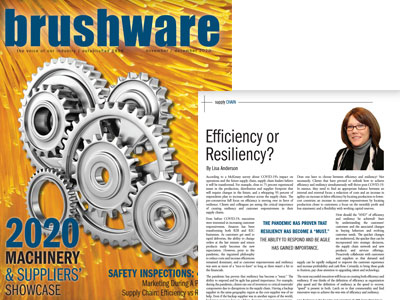According to a McKinsey survey about COVID-19’s impact on operations and the future supply chain, supply chain leaders believe it will be transformed. For example, close to 75% experienced issues in the production, distribution and supplier footprint that will require changes in the future, and a whopping 93% of respondents plan to increase resilience across the supply chain. The pre-coronavirus full focus on efficiency is moving over in favor of resilience. Clients and colleagues are seeing the critical importance of creating resiliency and customer responsiveness in their supply chain.
Even before COVID-19, executives were interested in increasing customer responsiveness. Amazon has been transforming both B2B and B2C businesses. As customers get used to rapid deliveries, the ability to change orders at the last minute and easy returns, it becomes the new expectation. However, prior to the pandemic, the ingrained philosophy to reduce costs and increase efficiencies remained dominant, and so customer responsiveness and resiliency was seen as more of a “nice-to-have” so long as there wasn’t a hit to the financials.
The pandemic has proven that resiliency has become a “must”. The ability to respond and be agile has gained in importance. For example, during the pandemic, clients ran out of inventory or critical materials/ components due to disruptions in the supply chain. Having a backup supplier in the same geographic region as the core supplier was of no help! Even if the backup supplier was in another region of the world, lead times were too long to address changing customer requirements. If your backup source of supply was close to your manufacturing operations and consumer demand, you were most likely still out of luck unless you had consistently ordered supply from your secondary backup supplier so you’d gain priority. The need for resiliency has become clear.
Do we have to choose between efficiency and resiliency? Not necessarily. Clients that have pivoted to rethink how to achieve efficiency and resiliency simultaneously will thrive post COVID-19. In essence, they need to find the appropriate balance between an internal and external focus, a reduction of costs and an increase in agility, an increase in labor efficiency by locating production to lower cost countries and an increase in customer responsiveness by locating production closer to customers and a focus on the monthly profit and loss statement and creating flexibility with working capital reserves.
How should we achieve the “AND” of efficiency and resiliency? Start by understanding your customers’ customers, and the associated changing buying behaviors and evolving customer needs. The quicker you pick up on these changes, the quicker they can be incorporated into your strategic decisions, your supply chain network and your new products and services offerings. Proactively collaborate with customers and suppliers so that you can rapidly realign demand and supply to improve the customer experience, increase profitability and cash flow. Certainly, to bring these goals to fruition, you’ll need to pay close attention to upgrading your talent and technology.
The most successful executives will focus on creating both efficiency and resiliency. If you think of the definition of efficiency as organization plus speed, and you think of the definition of resiliency as the speed to recover, you’ll find speed in common. Latch on to that commonality and find innovate ways to achieve the win-win of efficiency and resiliency.
As originally published in Brushware Magazine on November 2020



